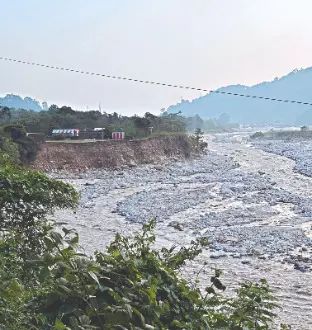Unchecked growth, fragile hills: Making of a Himalayan crisis

DARJEELING: As North Bengal struggles to recover from the devastating floods and landslides of October 4 — which have claimed over 35 lives and left many missing — questions are being raised on what went wrong and why the extent of damage could not be minimised despite an existing warning of heavy rainfall.
The worst affected areas are those located along riverbanks, both in the hills and plains. Numerous homestays and restaurants built on or near riverbeds have been swept away or buried under silt and debris. Environmentalists have long warned against unregulated construction on riverbeds and the absence of buffer zones along rivers.
In June 2024, the West Bengal Irrigation and Waterways Directorate issued a circular warning against unapproved riverfront construction and mandated prior vetting or NOC for any such projects. The circular cited dangers from flash floods and river course changes. However, on-ground implementation remains negligible. India already has provisions for “floodplain zoning,” aimed at regulating land use in flood-prone areas, but very few states have enacted or enforced this legislation effectively.
“The Himalayas have a very different geography. Both perennial and non-perennial rivers exist in Kalimpong and Darjeeling. During dry months, people assume the dry channels are safe for construction. These channels get choked with waste, turning into dumpyards, which contributed to the recent disaster,” explained Shreya Gurung, watershed and disaster management expert.
Gurung emphasised the need for sustainable development and decentralised planning. “Watersheds must be scientifically studied. We need strict restrictions and proper dissemination of data at the community level,” she said.
Echoing similar concerns, Mamata Desai, an environmentalist and geographer with over 25 years of experience in Himalayan hazard management, questioned the logic of building large dams in a fragile mountain range. “The Himalayas are geologically young, made of quartzite, gneiss, and phyllite — all fragile rocks. Yet there are at least five major dams on the Teesta in Sikkim and North Bengal, with more in the pipeline,” she pointed out. Referring to Bhutan’s massive Tala dam, Desai added: “Bhutan has fragile dolomite hills. The dolomite-laden water released from the dam reached as far as Alipurduar and even the Buxa Tiger Reserve, leaving a coating of dolomite. Such mega-projects should be replaced with small hydel projects of 4–5 MW, managed locally.” She also blamed unregulated construction and deforestation for worsening the situation. “Boulders have been extracted from riverbanks, deforestation is rampant on the banks where resorts have come up. No construction should also be allowed on slopes above 33 degrees. Rock detailing and slope aspect analysis must be made mandatory,” Desai stressed.
With a growing number of tourists opting for remote destinations, the Hills are witnessing a construction boom even in their far-flung rural areas. In Darjeeling district alone, there are 425 registered homestays, with 146 more awaiting approval. Kalimpong has over 1,135 registered homestays, with dozens more being built — many in vulnerable zones.
“Despite accurate meteorological forecasts, we failed to act,” said Wing Commander (Retd.) Praful Rao, founder of Save The Hills, a Darjeeling-based NGO monitoring landslides. “The IMD had issued a heavy rainfall warning six days before October 4. What did we do with that information? Nothing,” he remarked.
Rao said the region continues to lack preparedness. “Mirik lost 11 people in the landslides, but we don’t even have a functional weather station or rainfall data there. Automatic weather stations can be installed in every block at minimal cost,” he said.
He also called for community-level vigilance and disaster training. “Watch groups must be formed, especially among the youth. During heavy rains, night-time vigilance can save lives. Old British-era drains need immediate upgrading — many are now clogged or water pipes run through them,” added Rao. As North Bengal mourns its dead and clears the rubble, experts opine that unless environmental safeguards,
scientific planning, and disaster preparedness become priorities, such tragedies will keep repeating that too with increasing ferocity.



